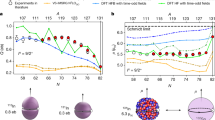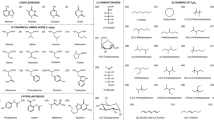Abstract
WHEN the nuclear quadrupole interaction frequencies of some aryl iodo-compounds are plotted against the corresponding half-wave potentials of these compounds at pH 7 (Fig. 1) a general linear trend is obvious; but the departure from linearity in the case of the iodoanilines is more serious (points not shown on graph). The data are taken from results obtained by E. Gergely and me1, those of Colichman and Liu2, and the quadrupole interaction measurements of Hatton and Rollin3, and of Barnes, Miller and Wooten4. Colichman and Liu have attempted a correlation of their polarographic data on iodo-compounds with Hammett's σ-function. Hatton and Rollin have attempted a similar correlation of their quadrupole data and Hammett's σ for bromine and iodine compounds. However, Colichman and Liu found the same misbehaviour of p-iodoaniline as we did, and it is equally obvious that the m- and p-di-iodobenzenes (as evidenced from our own results which are not substantially different from theirs) would not fit their straight line. On the other hand, Hatton and Rollin found, in their quadrupole – σ relationship, that these three substances fell very well into line. It is clear that the triangular agreement we expect to find from the results of these four groups of workers is very imperfect, and the interrelation of the three phenomena greatly in need of clarification.
This is a preview of subscription content, access via your institution
Access options
Subscribe to this journal
Receive 51 print issues and online access
$199.00 per year
only $3.90 per issue
Buy this article
- Purchase on Springer Link
- Instant access to full article PDF
Prices may be subject to local taxes which are calculated during checkout
Similar content being viewed by others
References
J. Chem. Soc., 3226 (1953).
J. Amer. Chem. Soc., 76, 913 (1954).
Trans. Farad. Soc., 50, 358 (1954).
J. Chem. Phys., 22, 946 (1954).
Duchesne, J. Chem. Phys., 20, 1804 (1952).
J. Amer. Chem. Soc., 59, 96 (1937). Jaffé, Chem. Rev., 53, 191 (1953).
Robinson, Dehmelt and Gordy, J. Chem. Phys., 22, 511 (1954).
Author information
Authors and Affiliations
Rights and permissions
About this article
Cite this article
IREDALE, T. Correlation of Nuclear Quadrupole Interaction Frequencies with Polarographic Half-Wave Potentials. Nature 177, 36–37 (1956). https://doi.org/10.1038/177036b0
Issue Date:
DOI: https://doi.org/10.1038/177036b0
This article is cited by
Comments
By submitting a comment you agree to abide by our Terms and Community Guidelines. If you find something abusive or that does not comply with our terms or guidelines please flag it as inappropriate.



